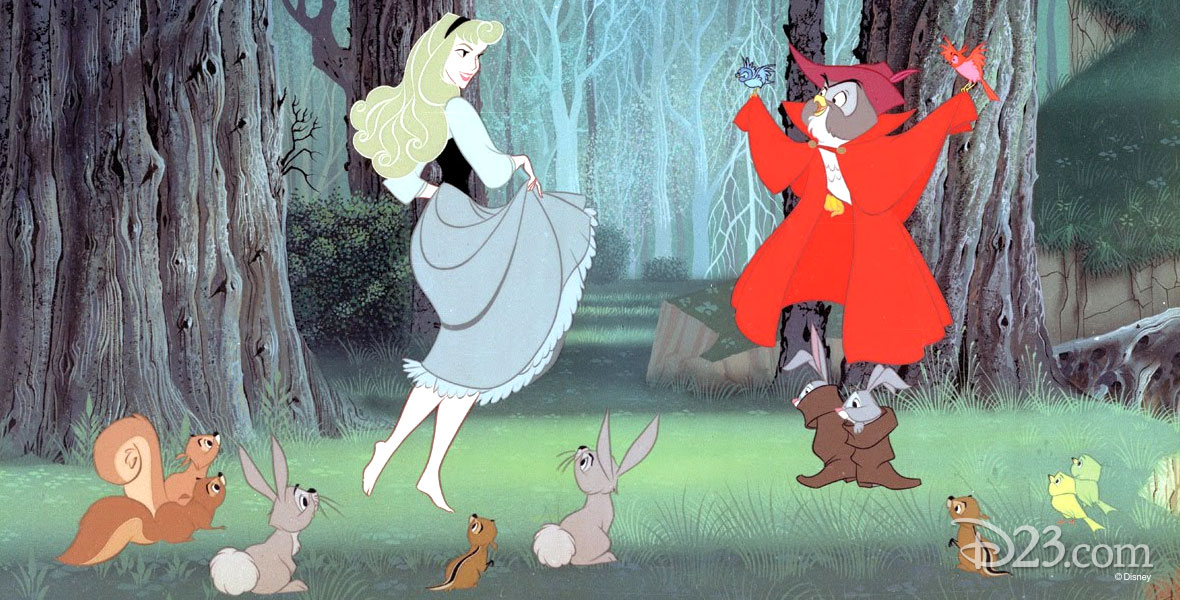In animation art circles, the work of artist, illustrator, and author Eyvind Earle is renowned, revered, and still influential today. That this remarkable and diverse talent came to call The Walt Disney Studios home for nearly a decade of his career is a testament to his talent—and to the artistic vision of Walt Disney himself.
Born on April 26, 1916, in New York City, Eyvind moved with his family to California two years later. His father, Ferdinand P. Earle, was, in Eyvind’s words, “ …an artist, a writer, a poet, played the violin, produced and directed a motion picture… just to mention a few of his activities.” His mother, Charlotte, was a concert pianist.
At age 10, Eyvind’s father challenged his son to either read 50 pages of a book or paint a picture every day—he did both. By age 14, he had already had his art exhibited in France, and in 1937 he had his first show in New York City. Subsequent exhibitions sold out, with one piece going into the collection of the Metropolitan Museum of Art.
He began designing Christmas cards in 1938, a sideline he would continue through most of his life. More than 800 card designs were created for the American Artist Group alone.
“As of 1985, I estimate that American Artist Group has sold well over 300 million of my cards,” Eyvind once said.
He came to the Disney studio in 1951, working on background artwork for Peter Pan. He also painted the illustrations for Walt Disney’s Peter Pan and Wendy, the Little Golden Book adaptation of the film. He continued to develop his style in memorable shorts, including For Whom the Bulls Toil, Working for Peanuts, Pigs is Pigs, and Grand Canyonscope. He contributed to 1953’s Toot, Whistle, Plunk and Boom, which won an Academy Award®. As Disney shorts became more experimental, Eyvind provided backgrounds and color styling to Jack and Old Mac, The Truth About Mother Goose, and Paul Bunyan.

But the pinnacle of his work for Disney was the landmark 1959 feature film Sleeping Beauty, for which he was responsible for the overall production design, including styling, background, and color.
“There are clear influences from the Renaissance in his work,” said film writer Justine Smith, “and his backgrounds owe much to those of Leonardo Da Vinci and Raphael.
He utilizes color to emphasize the sheer breadth of his worlds, shedding the far off backgrounds in green-bluish tones, a technique that Da Vinci used extensively.”
In 1958, Eyvind appeared with his colleagues Walt Peregoy, Marc Davis, and Joshua Meador in the short film 4 Artists Paint 1 Tree, aired as part of the Disneyland TV episode “An Adventure in Art,” which became a staple in art classrooms for decades.
He returned to full-time painting in 1966, producing watercolors, oils, sculptures, drawings, and scratchboards. Always a very personal artist, much of his work from this era was not seen or exhibited in his lifetime.
In 1987, Sleeping Beauty Castle (La Chateau de la Belle au Bois Dormant) and its surroundings for Disneyland Paris were created based on Eyvind’s film designs. His former colleague Frank Armitage even created a concept painting in the distinctive Eyvind Earle style of the film.
At the same time, Eyvind was inspiring a new generation at Walt Disney Animation. Co-director Eric Goldberg recalls, “Mike Giaimo and Mike Gabriel and I were highly influenced by Eyvind Earle in designing Pocahontas.”
So, late in his life and career, Eyvind enjoyed a renaissance of acclaim. He was praised by such publications as Time, The Los Angeles Times, The New York Times, and The Art News. In 1998, Eyvind was honored at the 26th Annie Awards with the Winsor McCay Award for lifetime achievement in the field. He passed away in 2000, but his work continues to grace galleries around the world. Museums have purchased his works, and his paintings have been shown in several one-man exhibitions worldwide.
“For 70 years, I’ve painted paintings,” Eyvind once said, “and I’m constantly and everlastingly overwhelmed at the stupendous infinity of nature. Wherever I turn and look, there I see creation. Art is creating… Art is the search for truth.”



